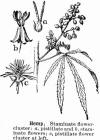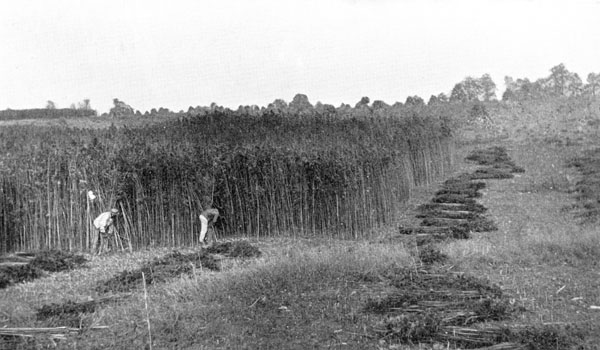

Harvesting Hemp for fiber in Kentucky, early 1900's
-Photo from James Lane Allen's The Reign of Law,
(New York, MacMillan & Co., 1900)
Hemp has been cultivated for centuries as a fiber plant. It was
grown by the early Greeks and probably by the ancient Egyptians. It has
been grown in this country for about 130 years [written in 1911], the
seed having been brought from France. During this time, its cultivation
has been confined chiefly to about twelve counties in central Kentucky,
in what is known as the blue-grass region. For the last forty or fifty
years, however, the industry has spread into a number of other states,
notably Missouri, Illinois, Nebraska, Oklahoma, Minnesota, New York and
California.
During the years it has
been grown in Kentucky, probably no other crop has brought in an equal
revenue. A few years before the Civil War it contributed more to the
wealth of central Kentucky than all other crops combined. At that time,
Kentucky produced annually 38,000 tons, with a gross receipt of
$2,280,000. during the war the industry declined but revived a few years
later, and again declined owing to the use of iron and jute in the
bagging of cotton. Hemp is now used largely for making burlap, twine and
carpet warp.
Culture
The soil: While hemp
will grow on almost any land containing a large amount of humus, it does
best on well-drained silurian limestone soils. In Minnesota it thrives
on drift soils. The moisture content is the important factor. The soil
should be prepared thoroughly by breaking with a turning plow, plowing
about six to eight inches deep, and by repeated harrowing and rolling.
Hemp grows so tall and
dense that it kills weeds by smothering them better than any other farm
crop. A good growth of hemp is effective in killing even Canada thistle
and quack-grass. It leaves the soil in excellent condition for any
succeeding crop.
Seeding: The best results are secured by sowing with a seven-inch
wheat drill, running it both ways. The seed is sown at the rate of one
bushel per acre. It is sown about two inches deep. After sowing, the
land should be rolled. Hemp should not be sown very thick, because in
thinning itself it will crowd out many plants and the size of the hemp
stalks will not be uniform. The best fiber is obtained from stalks about
one-half inch in diameter; if a thin stand is secured, the stalks will
frequently grow to be three-fourths of an inch in diameter.
-L.H.
Bailey, 1911
Reference
material for the above included the fine work from 1900 by S. S. Boyce,
Hemp, A Practical Treatise on the Culture of Hemp for seed and Fiber,
with a Sketch of the History and Nature of the Hemp Plant
(available from Cooper Smith Publishing).